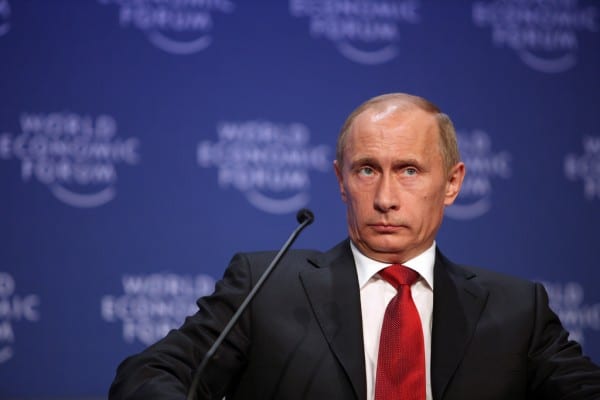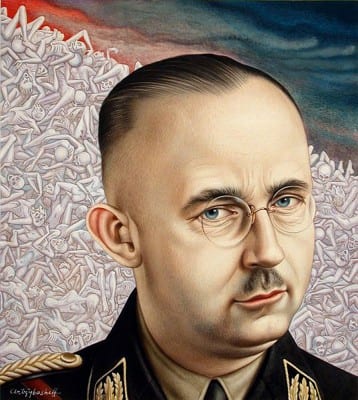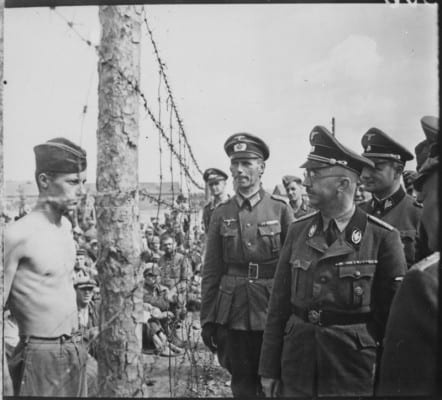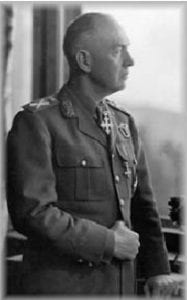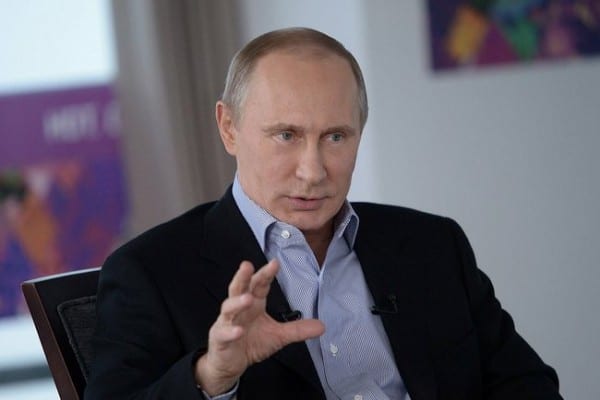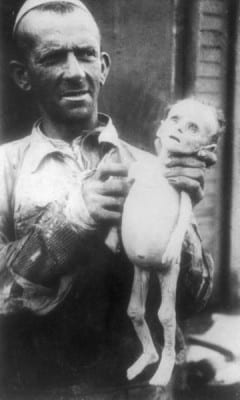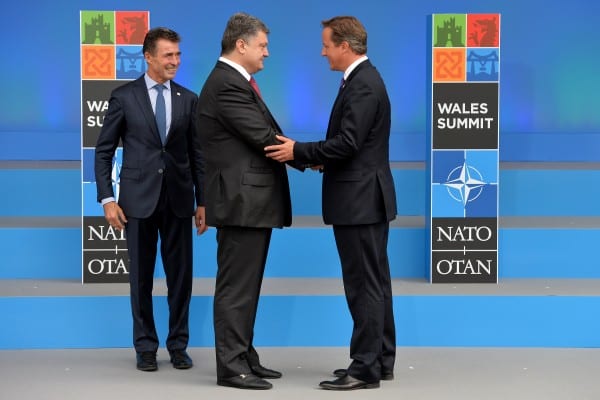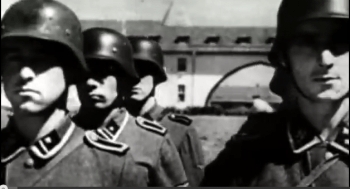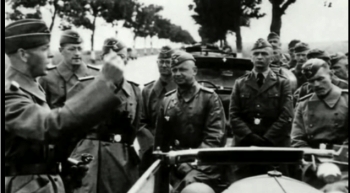Soviet Prisoners of War: Forgotten Nazi Victims of World War II
Jonathan North

Generalmajor Erich von Manstein. Of old aristocratic Prussian stock, he was active in the invasion of the Soviet Union and the Siege of Sevastopol, and was promoted to field marshal on 1 July 1942. He also participated in the Siege of Leningrad.
[dropcap]As the dust[/dropcap] This campaign of selective memory picked up steam as relations between the former Allies deteriorated and experienced officers of the Wehrmacht were seen as possible assets in any future war between the West and the Soviet Union. By 1946 the impression that the Wehrmacht had fought a chivalrous war, despite the pressure from above to be brutal, was becoming accepted as gospel by some in the West. Even with the passage of 60 years, this impression remains largely unchallenged. While it is true that the Wehrmacht generally fought within the recognized rules of war in Western Europe, the conflict on the Eastern Front was entirely different. In the vast expanse of the Soviet Union, the Wehrmacht was responsible for some of the worst excesses of the war.
READ MORE ABOUT VON MANSTEIN’S SWIFT CONVERSION INTO A CLEAN CITIZEN SOLDIER IN THE NEW GERMANY, WITH THE AMERICANS AS HIS NEW CLIENTS.
[learn_more caption=”NAZI VON MANSTEIN’S TYPICAL FAST TRACK REHABILITATION AND COLLABORATION “]
As a military advisor to the West German government in the mid-1950s, he helped re-establish the armed forces. His successful memoir, Verlorene Siege (1955), translated into English as Lost Victories, was highly critical of Hitler’s leadership, and focused strictly on the military aspects of the war while ignoring its political and ethical contexts. Manstein died in Munich in 1973.
SOURCE: WIKIPEDIA [/learn_more]
Nuremberg Trials. Defendants in the dock. The main target of the prosecution was Hermann Göring (at the left edge on the first row of benches), considered to be the most important surviving official in the Third Reich after Hitler’s death. In the end, only a few paid the ultimate price and many unrepentant Nazis were quickly reabsorbed into West Germany’s social fabric, and later the Western “struggle” against Communism. (US Gov./CC) / Click images to expand them to max. res.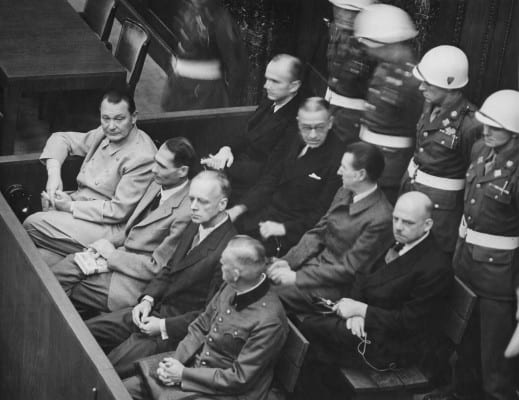
Careful scrutiny, however, shows how frail these arguments are. Germany’s armed forces played their role as the vehicle for the Reich’s expansion to the full, and through their own deliberate policies caused the premeditated death of millions of POWs.
Before Operation Barbarossa began in 1941, the Wehrmacht determined that Soviet prisoners taken during the upcoming campaign were to be withdrawn from the protection of international and customary law. Orders issued to subordinate commands suspended the German military penal code and the Hague Convention, the international agreement that governed the treatment of prisoners. Although the Soviets had not signed the Geneva Convention regarding POWs, the Germans had. Article 82 of the convention obliged signatories to treat all prisoners, from any state, according to the dictates of humanity.
In March 1941, Hitler issued what has come to be known as the ‘Commissar Order,’ which clearly spelled out the future nature of the war in Russia. The coming conflict was to be ‘one of ideologies and racial differences and will have to be waged with unprecedented, unmerciful, and unrelenting hardness.’ It also instructed Hitler’s subordinates to execute commissars and exonerated his soldiers of any future excess. ‘Any German soldier who breaks international law will be pardoned,’ the Führer stated. ‘Russia did not take part in the Hague Convention and, therefore, has no rights under it.’
At a subsequent gathering to explain the application of this order to senior army officers, General Edwin Reinecke, the Reich officer responsible for the treatment of POWs, told his audience: ‘The war between Germany and Russia is not a war between two states or two armies, but between two ideologies — namely, the National Socialist and the Bolshevist ideology. The Red Army [soldier] must be looked upon not as a soldier in the sense of the word applying to our western opponents, but as an ideological enemy. He must be regarded as the archenemy of National Socialism and must be treated accordingly.’ Reinecke continued with the admonishment that this must be made plain to every officer taking part in the operation,’since they were apparently still entertaining ideas which belonged to the Ice Age and not to the present age of National Socialism.’ Under the direction of the Commissar Order, immediately after capture all Soviet political officers should be killed and that thereafter, under a’special selection program of the SD [Sicherheitsdienst, the Nazi Party’s security service], all those prisoners who could be identified as thoroughly bolshevized or as active representatives of the Bolshevist ideology’ should also be killed.
On September 8, 1941, three months after the start of Operation Barbarossa, Reinecke reminded his subordinates, ‘the Bolshevik soldier forfeited every claim to be treated as an honorable soldier and in keeping with the Geneva Convention.’ Admiral Wilhelm Canaris, chief of the Abwehr (German intelligence), objected to Reinecke’s assertions but was quieted by Field Marshal Wilhelm Keitel, who reminded the admiral, ‘This struggle has nothing to do with soldierly chivalry or the regulations of the Geneva Conventions.’ It is interesting to note that while Hitler’s armies felt themselves relieved from the ‘niceties’ of international law during the campaign, the soldiers of their Finnish, Italian and Romanian allies regularly acknowledged the rights of Soviet soldiers under their protection.
The other feeble line of reasoning to explain away the mass deaths of Russian POWs is that the supply problems were out of the generals’ control. Here again, however, the facts fail to support the argument. From the very beginning, German military planners expected large numbers of prisoners. Four months before the opening of the campaign, the Wehrmacht calculated that it would capture at least 2 to 3 million prisoners — 1 million in the first six weeks.
The true explanation for the millions of deaths lies in the Wehrmacht‘s very deliberate planning of how it was to treat its prisoners. With the war going Hitler’s way in 1941, there seemed little reason to observe the customs of civilized warfare; soon there would be nobody left to object. Rather, what was more important was that the generals prove their worth by demonstrating they were reliable partners in Hitler’s ideological war.
Traditional norms of conduct were discarded even before the campaign opened. In March 1941, as Reinecke was briefing Wehrmacht officers, plans were drawn up for how army units would collaborate with SS General Reinhard Heidrich’s Einsatzgruppen murder squads as the Germans moved eastward. Although a product of Hitler’s twisted mind, the manual explaining the particulars of how the Commissar Order would be applied was drafted by Wehrmacht lawyers. Guidelines for the Conduct of Troops in the Eastcalled for ruthless elimination of active or passive resistance. While it had been customary following earlier campaigns to issue orders absolving German soldiers of guilt, the Barbarossa Jurisdiction Order of May 13, 1941, had provided these protections before the campaign even began. Perhaps more important, German soldiers were informed of this protection and went into Russia believing there would be no consequence for their subsequent actions.
With their plans for invasion and treatment of POWs well in place, the Wehrmacht unleashed Operation Barbarossa on June 22. Its initial success shocked even the victors. The mechanized panzer columns rolled forward almost effortlessly and left in their wake tens of thousands of bewildered Soviet soldiers who were quickly and easily scooped up by infantry units following behind. The cruelty was apparent from the outset. Major General Heinz Hellmich, commanding the 23rd Infantry Division, ordered that white flags were not to be respected. ‘There will be no quarter!’ he raged. A Captain Finselberg of the division’s 6th Infantry Regiment told his troops to take no prisoners, as they were ‘useless consumers of food and anyway a race whose extermination would be a step in the right direction.’ Panzer Group 3 found prisoners guilty of having taken ‘measures against the German Wehrmacht‘ and shot them out of hand. On June 29, Field Marshal Günther von Kluge ordered, ‘Women in uniform are to be shot.’
Later, as their excesses ignited a protracted partisan war, the Germans reacted by issuing harsh orders calling for the execution of any Red Army personnel found in civilian clothing. An order to the 56th Infantry Division stated, ‘Soldiers in plain clothes mostly recognizable by their short hair are to be shot following their identification as Red Army soldiers.’ Villages were razed for sheltering Red Army soldiers, and prisoners were shot in retaliation for partisan attacks or for simply being soldiers. A field court-martial had sentenced a major to demotion for shooting POWs for no particular reason. Hitler intervened and excused the major, stating, ‘We cannot blame lively spirits when they, convinced as they are that the German people are engaged in a unique battle of life and death, reject the Bolshevik world-enemy beyond all commandments of humanity.’
As a reflection of the racial nature of the war, Jewish prisoners were often held for execution by mobile SD squads or by Wehrmacht commanders. Soldiers from the Soviet Union’s Asian republics were frequently shot out of turn, as were loosely defined ‘Communist agitators.’ So too were the wounded. In October 1942, wounded prisoners being held at Stalag 355 were being shot rather than treated. Seventy others, 18 of whom were amputees, were shot near the village of Khazhyn on December 24, 1942.
Those ‘lucky’ enough to escape the arbitrariness of their first moments as POWs were soon herded westward to begin their captivity. The marches were often as terrifying as combat itself. Nikolai Obrynba, a medic in a Soviet militia battalion hastily raised as the Germans pushed on toward Moscow, was captured in the fighting around Vitebsk. He remembered the exhausting march into captivity: ‘It was the fourth day of our march toward Smolensk. We spent the nights in specially furnished pens, enclosed by barbed wire and guard towers with machine gunners, who illuminated us with flares through the entire night. The tail of the column, which stretched from hill to hill, disappeared into the horizon. Whenever we halted, thousands of those dying from hunger and cold remained or they collapsed as we marched along. Those still alive were finished off by soldiers wielding submachine guns. A guard would kick a fallen prisoner and, if he couldn’t get up in time, fired his gun. I watched with horror how they reduced healthy people to a state of complete helplessness and death.’
Leonid Volynsky also remembered such shootings: ‘An exhausted person would be sat at the side of the road; an escort would approach on his horse and lash out with his whip. The prisoner would continue sitting, with his head down. Then the escort would take a carbine from his saddle or a pistol from his holster.’ Later, when confronted with these atrocities, General Alfred Jodl of the high command of the army (Oberkommando des Heeres, or OKH) explained them away with the feeble explanation that ‘prisoners who were shot were not those who could not, but those who did not want, to walk.’
Understandably horrified by what it was seeing, the civilian population became restless and uncooperative. To counteract this, an OKH report of August 1941, just three months after the invasion had begun, stressed that ‘force, brutality, looting and deception should be avoided in order to win over the population’ and that the treatment of POWs was a major source of hatred for the Germans. Alarmed that the will of the troops would be weakened by such kindly treatment toward the enemy, Jodl carefully noted in the margin of the report, ‘These are dangerous signs of despicable humanitarianism.’
Deliberate brutality and forced marches thinned the ranks of the POWs, but it proved to be an insufficient means of ridding the Germans of their unwanted burden. To further winnow the ranks, rations were systematically withheld from the prisoners. Food was earmarked for German use, and the army was to live off the land and dispatch any surplus to the Reich. Captured food worth 109 million Reichsmarks was sent to Germany from Russia between July and December 1941 alone. This distribution of resources was done with the full cooperation of the army, which acknowledged in another report, ‘Thereby tens of millions of men will undoubtedly starve to death.’
Prisoners marched through the rear area of Army Group Center, for example, were getting only 300 to 700 calories a day. Those attempting to supplement this bounty by grabbing food from fields passed along the way were instantly shot. In many cases even the civilian population was barred from assisting the prisoners. Dr. Evgeny Livelisha of the 44th Rifle Division remembered: ‘The peaceful civilians came to meet us, and tried to supply us with water and bread. However, the Germans would not allow us to approach the citizens, nor would they let them approach us. One of the prisoners stepped five or six meters out of the column and without any warning was killed by a German soldier.’
While the initial success of Barbarossa had been significant, the Germans failed to subdue the Soviet Union by the time the first snows fell in November 1941. The worsening weather made combat operations difficult for the German soldiers struggling to reach Moscow and caused the lot of their prisoners to grow even worse. When winter weather made it impossible to move prisoners by road, Wehrmacht directives were issued to have most men transported by rail but only in open wagons. In December 1941, between 25 and 70 percent of prisoners transported in this way perished en route. A prisoner named Gutyrya would be forever haunted by his trip to Stalag 304. ‘The experience in the wagons can hardly be described in words,’ he remembered. ‘Wounds bled and turned everything black. Men died in each wagon. They died of blood loss, tetanus, blood poisoning, or hunger, thirst and suffocation as well as other deprivation. This inhumane ordeal lasted for 10 days. The journey came to an end. At noon they unloaded the men. The dead were thrown out onto the platform.’
Whether by foot or by rail, the ultimate destination of most prisoners in 1941 were Russenlager, camps built specifically to house Russian prisoners and managed by the Wehrmacht. Organizational Order Number 37 of April 30, 1941, stipulated that the camps were to consist of barbed-wire enclosures and watchtowers. The Wehrmacht discounted the need for hospitals or canteens — quicklime and cooking pots were to be provided instead. Few of the camps had barracks of any kind. As cold weather set in, the inmates were forced to dig shelters into the earth. The commandant of Stalag 318 noted that his charges were ‘digging holes in the ground with their mess-kits and bare hands’ as early as September 1941. Pavel Atayan was one of those who resorted to such improvised shelter. ‘You just had to dig yourselves a hole in the ground to sleep in and we slid inside there, four at a time; you had to find room to bend your legs. We were really cold. It was winter. Every day they sent a cart to pick up the dead.’
When the frost and snow came, however, even those shelters were of little use. Many died of exposure in that living hell, but far more died through starvation. The frontline army policy in Russia of withholding food was continued in the camps, which given their fixed location should have been able to receive and distribute what was necessary. Although some prisoners were doubtlessly hungry when captured, the bulk of the deaths in 1941 actually took place hundreds of miles from the front, weeks or months after capture. As administrators of the Russenlager, it was the OKH that set the amount of rations to be supplied or withheld.
The quantity, to say nothing of the quality, of the food received by the Soviet POWs was set far below the minimum required for human survival. Xavier Dorsch noted that in the camp he helped guard at Minsk, ‘The problem of feeding the prisoners being insoluble, they have largely been without nourishment for six to eight days and are almost deranged in their need for sustenance.’ Another guard, Johannes Gutschmidt at Dulag 203, recorded in his diary that conditions in his camp soon reduced the prisoners to beasts. ‘There was nothing to eat, not even any water. Many died. Finally they gave them dry macaroni and they fought over it.’
Victor Yermolayev was on the receiving end of such largess. ‘After a few days, they began throwing us packets of semolina, dehydrated semolina, they threw them to us…some caught them…and others couldn’t. We fell on it like wolves!’
The commandant of Stalag 318, a Colonel Falkenberg, noted on September 11, 1941: ‘These cursed Untermenschen [sub-humans] have been observed eating grass, flowers and raw potatoes. Once they can’t find anything edible in the camp they turn to cannibalism.’ ‘The prisoners live in the open air,’ a witness to conditions at the Karolowka camp reported. ‘At the camp the hunger is so terrible that a mile away they can be heard groaning and shouting `Food.’ They eat grass. Dozens die from starvation.’ A Hungarian tank officer recalled: ‘I woke up one morning and heard thousands of dogs howling in the distance. I called my orderly and asked, `Sandor, what is all that moaning and howling?’ He answered: `Not far from here there is a huge mass of Russian prisoners in the open air. There must be 80,000 of them. They are wailing because they are starving to death.”
Rations scarcely resembled food at all. The prisoners’ bread was specially formulated for Russians by the German Ministry of Food on November 24, 1941. The ministry advised its bakers that ‘a useful mixture consists of 50 percent rye bran, 20 percent residue of sugar beet, 20 percent cellulose flour and 10 percent flour made of straw or leaves.’ When made aware of these conditions, Reichsmarshall Hermann Gring and his staff helpfully suggested that the prisoners be allowed to eat cats. The Ministry of Food replied: ‘Animals not normally consumed will never do much to satisfy the need for meat. Rations for Russians will have to be based on horse meat and meat stamped by inspectors as unfit for human consumption.’
Gabriel Temkin, taken prisoner in 1942, remembered some of those meals. ‘All we were getting to eat was watery soup with pieces of rotten meat, a diet that was literally decimating us. It was the flesh of dead horses killed and lying alongside the roads since the German air strikes in the first week of July that was now to become our staple. The horses, their swollen bellies and open wounds full of white maggots and other parasitic worms, were collected by prisoners on adjacent roads.’
As the campaign continued, conditions in the camps became even worse. The army revised rations — downward. On November 13, 1941, the quartermaster-general, a Colonel Eduard Wagner, stated boldly that sick prisoners ‘should starve’ and that rations for the remaining prisoners should be reduced — just before the onset of winter. Even those enmeshed in the Nazi regime saw that, had the will been there, the prisoners could have been fed. Alfred Rosenberg, the Reich minister of the Eastern Territories, complained to Field Marshal Keitel, ‘In the majority of cases, the camp commanders have forbidden the civilian population from putting food at the disposal of prisoners and they have rather let them starve to death.’ Allied officers at Colditz were barred from sharing Red Cross parcels with Soviet prisoners. In 1940 French POWs had been allowed to take supplies from German reserves. No such rights were granted officials supplying Soviet prisoners.
Under such deplorable conditions, disease began to stalk the camps. Tetanus and blood poisoning, diphtheria, malaria, pellagra, tuberculosis, pneumonia and typhus decimated the camps. In Stalag 304, prisoner Gutyrya remembered that in the wake of starvation, ‘the typhoid fever epidemic began.’ He continued: ‘Up to 500 men died of this illness each day. The dead were thrown in mass graves, one on top of the other. Misery, cold weather, hunger, disease, death. That was camp 304.’
If the question had been simple logistics, as was later claimed, then the offer of outside assistance should have been readily accepted. Such was not the case. A Red Cross overture of vaccination equipment in the winter of 1941, during the epidemic, was rejected by Hitler. Soon the Wehrmacht began to formulate its own system for dealing with the sick and diseased. Many were quarantined in isolation camps; others were shot. In December 1941, one camp commandant noted that 1,000 wounded or sick prisoners had been brought to open-air collection points ‘where they mostly soon perished in the cold.’ At Stalag 324, it became customary for the sick to be shot once a week. An epidemic of dysentery at Stalag 359B led to a grisly final solution. Between September 21 and 28, 1941, Police Battalion 306 launched Operation Chickenfarm, which saw some 6,000 Red Army prisoners shot by German troops — 3,261 of them on the first day. In the subsequent report detailing the murders, victims were described as ‘laid eggs.’
The result of all this abuse was that the daily mortality in an average camp was from 80 to 150 men. By January 1942, this equated to an average of 6,000 men per day. Less than a year after the start of Operation Barbarossa, in April 1942, a total of 309,816 prisoners had died in the camps in Poland alone. One German official in the occupied territories coldly noted that as of February 19, 1942, of the 3.9 million prisoners taken to that point, only 1.1 million remained in the camps. Some 280,000 prisoners, mainly Balts and Ukrainians, had been given the dubious privilege of being sent from almost certain death in the Russenlager to begin the slow death of work as slave laborers. The rest had simply perished.
When the process of ‘disposing’ of excess prisoners through abuse or neglect proved to be inefficient, the Wehrmacht streamlined their system by turning to the experts. Prisoners sent to Munich’s Stalag VIIA for forced labor were inspected upon arrival by local Gestapo agents. Of the 3,778 prisoners who arrived, some 484 were found to be ‘undesirable’ and immediately sent to concentration camps and murdered.
While it is true that in this instance the Wehrmacht did not carry out the actual executions, it had released the prisoners from its control, placed them on the trains that took them to Germany and, once the loading had been completed, marked the prisoners’ identity cards with ‘transferred to the Gestapo.’ Those prisoners sent to Stalag VIIA were not the only ones to receive such treatment. Sachsenhausen concentration camp alone executed 9,090 Soviet POWs between August 31 and October 2, 1941. Auschwitz, Buchenwald, Dachau, Flossenburg, Gross Rosen, Mauthausen and Neuengamme all received similar ‘deliveries,’ which they handled in a like fashion.
In addition to supplying labor for Germany, the Wehrmacht was also quite happy to provide prisoners for medical experimentation. In one such case, a Dr. Berning killed 12 prisoners from Stalag 310 while performing experiments on their digestive systems. In another, prisoners were shot using dum-dum bullets so the effect of the munitions could be assessed.
The policy of deliberate extermination eventually abated as the realization began to sink in that the campaign in Russia would not be the lightning victory that had been planned. Only in the late autumn of 1941, when Germany’s wartime economy began to feel the strain of the now global conflict, was the decision made for the greater employment of POWs. From then on, surviving Soviet prisoners were used as slave labor. Many were dispatched to the Reich’s coal mines — between July 1 and November 10, 1943, 27,638 Soviet POWs died in the Ruhr coal pits alone. Others were sent to Krupps, Daimler Benz or farmed out to countless smaller companies.
Although the generals later claimed that they were busy fighting the war and were thus not responsible for what happened behind the front, the fact remains that the Wehrmacht retained responsibility for the prisoners destined to forced labor, assigning their rations, allocating them to specific industries, guarding the columns as they headed west and maintaining the miserable Russenlager. When the prisoners eventually succumbed, it was Wehrmacht personnel who recorded their deaths and registered and oversaw their burial. Giving the lie to later claims that ‘they did not know,’ German civilians regularly witnessed bands of weary, starving Russian prisoners moving throughout their country.
They were not the only ones. As more and more Russians were sent westward, they were frequently collected in camps that were next to the POW compounds set up for prisoners from the other Allied countries. The abuse of Russian prisoners had become such that American, British and French POWs frequently commented on the mistreatment they witnessed.
After the war, when the full horror of what had transpired in Hitler’s Reich became known, the Allies set up criminal courts to try the worst offenders. While the SS and other police organizations were, correctly, confronted with their crimes, the Wehrmacht largely escaped such scrutiny. Although a few high-ranking generals were tried, including Jodl and Keitel, Wehrmacht personnel who had actively participated in the systematic abuse and murder of Soviet POWs went unpunished.
The fact remains, however, that the Wehrmacht actively assisted in the planning and execution of the war. It is also undeniable that its conduct of the war included a POW system that violated international treaties and the rules of war in its treatment of Soviet prisoners. This was vastly different from its treatment of other Allied prisoners. Contrast the way in which the Wehrmacht safely herded 2 million French prisoners into the Reich in 1940 with the death marches of Russian prisoners of late 1941.
The Wehrmacht actively formulated the way Soviet prisoners should be deprived of the protection of international law, handed prisoners over to the SD for execution, set starvation rations, deprived prisoners of essential medical assistance, organized a system of camps designed to be primitive, farmed prisoners out for slave labor and deprived them of rights normally associated with POW status. Most damning is that those excesses were the result of deliberate planning prior to the invasion of Russia and were not the unfortunate result of the ‘chaos’ of war.
Despite the Wehrmacht‘s feeble efforts to hide its crimes behind a veil of secrecy, Russian soldiers and civilians were well aware of the mistreatment. Such knowledge strengthened the resolve of the Soviets to fight on until it was the Germans who were on the defensive. It also ensured that as Soviet armies advanced westward, their wrath would be terrible.
There can be no excuse for the horrible excesses committed by Soviet troops in Germany, but the Wehrmacht‘s treatment of Russian prisoners might serve as one possible explanation for their behavior. Far more than half the Soviet soldiers taken prisoner by the Germans during the course of World War II died in captivity. Sixty years later, a full accounting of the Nazi regime and the brutality of the war on the Eastern Front requires that politicians, legal authorities, historians and students of the war hold the Wehrmachtaccountable for its actions and seek justice for its victims.
ABOUT THE AUTHOR
This article was written by Jonathan North and originally appeared in the January/February 2006 issue of World War II magazine.

